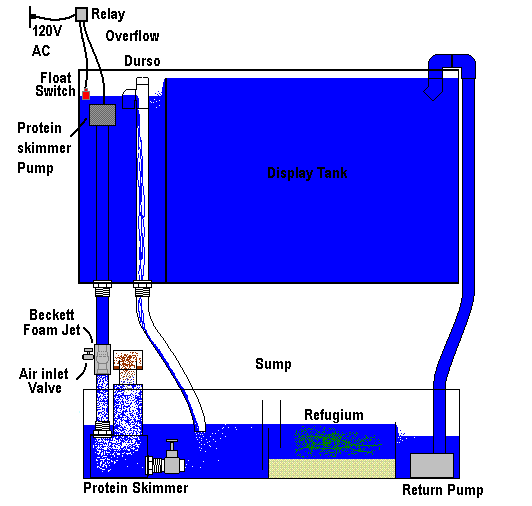About my reef
Reef Tank Aquarium Setup DIY
It was inevitable that I would eventually start a reef tank. I had grown up keeping fresh water fish for all their ease and cost, yet I was always drawn to the reef display at the LFS
Eventually came to reality and after much reading, pondering, and designing, I have built a reef system that I hope will be beautiful to look at, easy to maintain, operate quietly, and provide a healthy environment for both fish and corals.
In my quest to build a reef system, I found the web an invaluable source of information. In creating this site, I hope to share my successes and discoveries that will benefit anyone wishing to start a reef tank. Happy reefing!
Saltwater reef tank setup
For most people, A reef tank is very likely the single most beautiful “decoration” most people have in their homes. I wanted not only to add a highlight to the house, I wanted it be a bigger part of everyday life than just sitting along a wall in one of my rooms. I wanted it to alter my normal everyday experiences at home. I also wanted it to be in a place where visitors would be comfortable approaching to get a closeup. I wanted to be forced to walk by it a hundred times a day, and be able to peer into it without having to stoop. My answer was to build it into the wall in a central location (above the bar along the entrance to the kitchen) and taller then normal.
Tank gallery
Absolutely quiet fish tank
Growing up one of the things you just “get used to” is that standard aquarium equipment and setups emit quite a bit of noise. While some find the hum “soothing” most of us put up with it competing with the sounds of the TV and nearby discussions. Water trickling, pumps humming. Air stones hissing. For me these sounds distract from the beauty that any tank provides not to mention complete with other things in the home like the TV or phone. I really think an aquarium should be seen, but not heard.
I set out to make a quiet fish tank. Absolutely quite. Without sacrificing on any the other things like water flow, air cooling, and a powerful skimmer, and efficiency. I don’t have basement or a place for a “fish room” to hide all my noisy equipment. My system had to sit in the stand under the tank. A pretty standard setup.
The answer to this quest was two fold. First minimize all the sounds generated by the system. Secondly keep the sounds from escaping. It’s interesting to look at commercial aquarium stands. The all seem to have a huge open back. I doubt this is to aid in allowing plumbing routing options for the customer. It is more likely the result of a reduction in material to remain competitive. These stands do absolutely nothing to keep sound in. I realized I would have to design and build my own stand and make sure I designed the system so the sound couldn’t escape.
Inexpensive and easy
to build components for your salt water reef aquarium
Protein SkimmerFloat SwitchSump DesignGravity Assisted PumpEasy maintenance reef tank
If you are to succeed at keeping a reef tank healthy, you must stay motivated to do regular Maintenance, or you will fail. I was hoping that I could do a water change without getting water in your mouth, touching the water, finding a bucket, finding a siphon hose, worrying that something could overflow or leak. I also wanted to have clean spares for skimmer bodies and filters to make swap out replacement. And cleaning on your own time.
Keep it simple
I was hoping to create a system that would be stable and handle a little stress if I wasn’t an angel at maintenence. If your fish aren’t eating or your corals are dying and it’s a struggle to keep the tank from going under – Or even if you can keep your tank in pristine condition, but can’t have a life too, then you’ve got a problem. I didn’t want a burden like that.
There are plenty of species of hardy corals and fish that that provide all the beauty and color that I am looking for. There is a huge selection in this area, and with proper aquascaping and placement, can create a beautiful environment.
This way I get to have a life, go on vacation, without being hog tied to the tank or always nervous that everything is ok.
Inexpensive and easy
to build components for your reef tank
Led MoonlightsKalk (Nilsen) ReactorSpray InjectorBuilding a Reef TankSimple and practical system setup diagram for your reef tank
The system cycles all water through each section of the sump. The return pump is a MAG12 and is pushing around 820GPH in this configuration. I have a Seio 820 stream pump in the display as well. These two pumps accomplish my wave generation by directing the stream to intersect in the center of the tank.
The skimmer is powered from a MAG 5 placed in the overflow compartment on the inlet of the drain tube that connects to the skimmer. This provides a way to harness the potential energy of the overflow water which is 5.5′ higher than the sump base. The 40 inch drop from the pump to the spray injection nozzle provides approx 1.5 PSI of additional pressure. The MAG 5 generates around 4.6 PSI so I get around 7 PSI in theory.
To keep the skimmer pump from running dry and to keep constant pressure on the injector, I route the extra water through 2 traditional durso topped stand pipes. Since the MAG 12 is pushing significantly more water than the MAG 5 does, the water level in the overflow stays at the durso inlet height. This keeps the MAG 5 completely enveloped with water so it doesn’t run dry and keeps it under constant pressure. I am planning to add a float switch to this compartment to ensure the MAG5 shuts off if the water level drops too low.
The refugium is handling more flow than is conventionally suggested, but my nitrates have remained at 0PPM for the last 4 months and my chaetomorpha macro-algae doesn’t seem to stop growing. The refugium is full of visible amphipods, bristle worms, fan worms and such.
General Reefkeeping tips
Reef tank tips and tricks
Pretty Tank
For in-tank plumbing use black pvc. You can buy it at Savko. It is much prettier than white and makes for a very professional look and is reasonably priced.
Painting the back of a glass tank looks far better then just placing something black behind the back glass even if you use the same paint. The air gap between the backdrop causes refraction reflection which makes the back a mirror at certain viewing angles. The mirror effect highlights anything growing on it besides not being the color you intended. Painting the back makes the back a solid color that looks great and consistent from any angle.
Not much is worse than a reef slide. It can scratch your acrylic or glass and kill your corals. All that live rock likes to shift around. Especially with all that water motion. I used a long 1/4″ drill bit (doesn’t have to be masonry) and made holes in my live rock and connected the pieces together using 1/4″ clear acrylic rod. Much like a tinker toy set only the rods inserted farther so as not to be visible. Not only did I make my tank impervious to reef slides since all the pieces are interconnected, I can also create shelves, coves, towers, and caves, that gravity will not allow by just stacking the rock. Aquascaping options galore!
Fixer Upper
Don’t glue any PVC fittings that you don’t have to. Pressurized lines like plumbing off of a return pump should be glued, some bulkhead connections like the the drainline from the overflow. But why glue in your stand pipe or fittings off of an in-sump skimmer, or even the separate pieces of a durso? The fittings keep pipes and plumbing snug enough while allowing you to make quick effortless changes to your plumbing.
Bad Practice
Eliminate or lessen the height of any waterfall in your system. Waterfalls create three undesirable things: Microbubbles, Noise, and Salt spray. Microbubbles are often undesireable to look at and scatter light. Noise imposes your aquarium on the rest of the room atmosphere. An aquarium should be seen not heard. Salt spray is ugly, causes salinity creep, decreases the life of electronics nearby, and degrades the surface materials of your hood, stand and any other surrounding materials.
My rule of thumb is less than 1 inch. My sump has no water falls. The fall over my display overflow weir is 0.5 inches. It’s also whisper quiet.
Noise
- Lessen waterfalls
- Implement a stand pipe drain silencer: Durso, Stockman, or Hofer Gurgle Buster
- In the sump, implement a bubble tower. A Bubble tower quiets the drainline at the water exiting side in the sump. A durso and a bubble tower will totally silence the drain in the system.
- Install the sump on a rubber mat to keep equipment vibrations from resonating out on to your stand.
- Install marine carpeting on the inside surfaces of the stand. Carpeting Will absorb sound keeping it from leaking out the cracks in the stand doors.
- Air intake silencers on the protein skimmer inlet and durso if necessary.
- Quiet pumps by adding “rubber” feet. A little dab of silicone on four corners is cheap and works nicely.





















